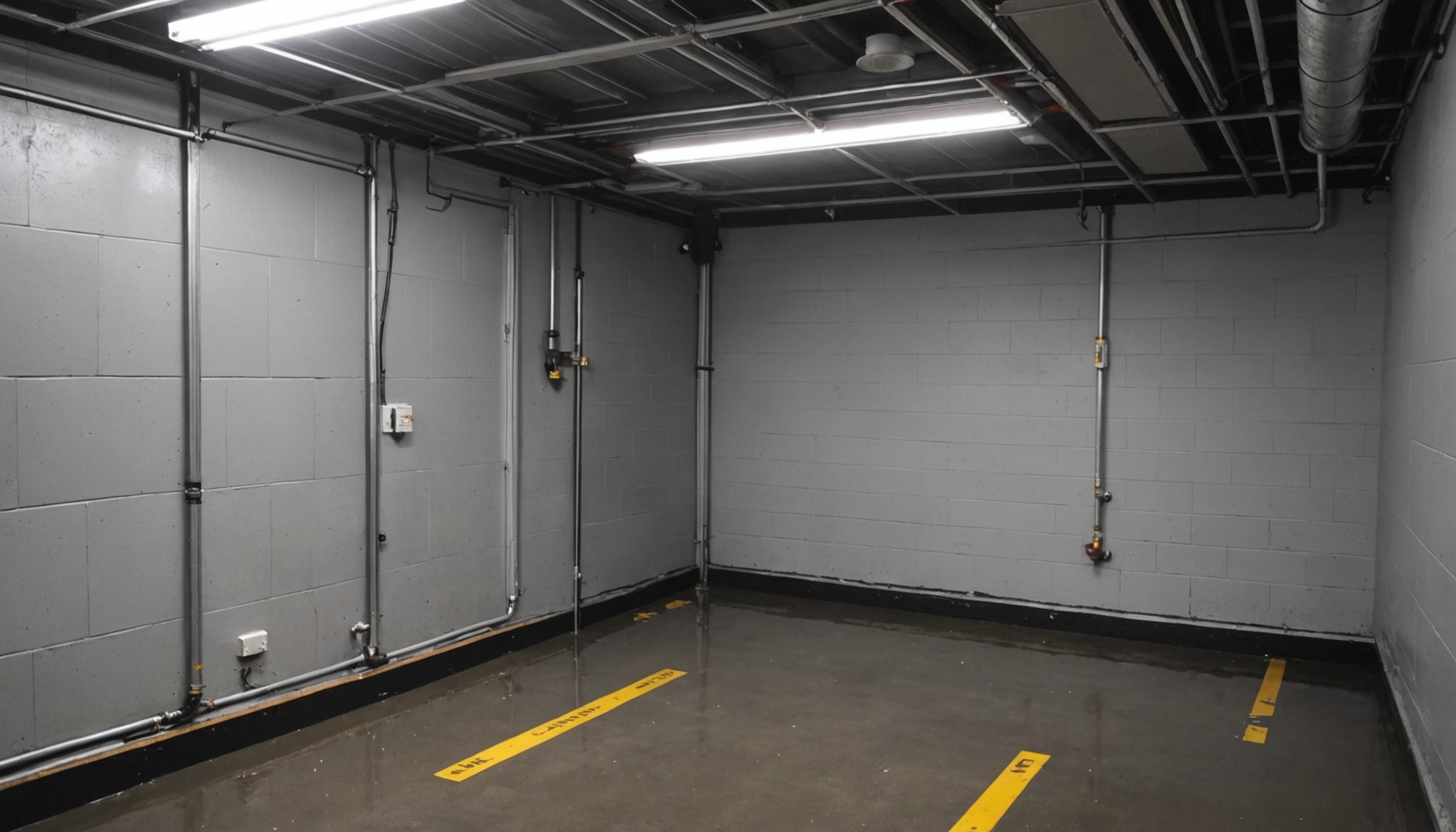Understanding Basement Waterproofing
Basement waterproofing is vital for protecting your home from damp and decay, especially in the notoriously wet UK climate. Its importance cannot be overstated, as dampness can lead to structural damage and health issues from mould. Waterproofing methods are specifically designed to prevent these problems by creating a barrier against water intrusion.
There are several common causes of basement dampness in UK homes. Heavy rainfall is a significant factor, as it can lead to water accumulation around the home’s foundation. Poor drainage systems also contribute, allowing water to seep into basements. Additionally, old or cracked foundations can let moisture in, exacerbating water issues over time.
This might interest you : Discover the Best Techniques for Effortlessly Eliminating Hard Water Stains from Bathroom Tiles in Kent
Before you embark on any basement waterproofing project, it’s crucial to consider key factors to ensure its success. First, assess the current condition of your foundation and identify any potential point sources of water entry. This involves a thorough inspection to look for cracks or weaknesses. It’s also important to evaluate existing drainage systems around your home, such as gutters and downspouts, to ensure they effectively direct water away from the foundation. Furthermore, understanding the unique challenges posed by your location and climate will guide your selection of the most suitable waterproofing methods and help in long-term damp prevention.
Effective Waterproofing Strategies
When it comes to keeping your home dry, understanding different waterproofing techniques can make all the difference. Let’s delve into the specifics of interior waterproofing versus exterior waterproofing.
Topic to read : Unlocking Your Loft: Essential Legal Guidelines for Loft Conversions in Birmingham
Exterior vs Interior Waterproofing
Exterior waterproofing involves dealing with water before it enters your home. This method requires sealing the outer walls and redirecting water away using drainage systems. It’s a proactive strategy to prevent moisture from penetrating in the first place.
Interior waterproofing, on the other hand, focuses on managing water that has already seeped in. It includes techniques like installing sump pumps or sealants that control moisture levels within your living space.
Implementing Interior Waterproofing
To implement interior waterproofing effectively, begin with an inspection to spot areas of ingress. Next, apply a sealant to cracks and gaps and install a sump pump or a dehumidifier to maintain low moisture levels.
Case Studies
In one successful waterproofing project, a homeowner used a combination of both methods. They fortified their basement with exterior waterproofing using a perimeter drainage system complemented by interior solutions that included a sump pump. This dual approach ensured a dry, safe environment throughout the year.
Relevant Regulations and Standards
Navigating the UK building regulations is crucial for any waterproofing project, especially when it comes to basements. These regulations ensure that buildings are safe, energy-efficient, and habitable. In terms of basement waterproofing, adherence to these rules isn’t just about compliance; it is about ensuring the longevity and safety of your structure.
The waterproofing standards in the UK encompass a variety of guidelines focused on preventing moisture intrusion and related structural issues. These standards are integral in creating spaces that remain dry, thus protecting both the environment and the inhabitants’ health. It’s essential to incorporate robust waterproofing systems that align with these standards to prevent costly repairs down the line.
Compliance is of utmost importance as it guarantees that the applied waterproofing solutions meet the mandatory performance criteria. Lack of compliance can lead to legal challenges and additional costs due to the need for subsequent corrections or reconstructions. Therefore, it is beneficial for property owners and contractors to stay informed about the relevant building codes.
For those seeking more detailed information, resources such as local authority websites, construction professionals, and regulatory documents can provide valuable insights. These resources offer guidance on adhering to UK building regulations and acquiring any necessary permits or inspections before commencing work.
Materials and Products for Waterproofing
When embarking on a waterproofing project, choosing the right waterproofing materials is crucial. This choice determines the effectiveness and longevity of the work. Sealants, membranes, and drainage systems form the foundation of waterproofing solutions.
Sealants are vital for preventing water penetration. They offer flexibility and adhesion but require precise application to avoid potential leaks. Among sealants, silicone-based variants stand out for their durability, while acrylic options are better for cost-effectiveness.
Next, waterproofing membranes come in two main forms: sheet and liquid. Sheet membranes are pre-formed and provide consistent protection, ideal for large, flat areas. On the other hand, liquid membranes are applied directly to the surface, offering flexibility around complex shapes but requiring skill for uniform coverage.
A well-thought-out drainage system is indispensable for managing water flow efficiently. Subsurface drainage systems, such as French drains, redirect water away from vulnerable areas, reducing pressure build-up and preventing potential water damage. These systems complement sealants and membranes, ensuring comprehensive protection.
Each waterproofing material and product has distinct advantages and drawbacks. Your choice should align with the specific needs of your project. Whether it’s the unparalleled sealing of silicone or the adaptive coverage of liquid membranes, understanding these options will guide you in creating an effective and enduring waterproof solution.
Cost Considerations in Waterproofing
Understanding the waterproofing costs is essential when planning a renovation to protect your home. The average expenses for waterproofing can vary widely depending on the method chosen. For instance, sealing small cracks might cost significantly less than a full exterior excavation. Generally, interior solutions tend to be more budget-friendly, while comprehensive exterior measures secure long-term benefits against moisture but at a higher cost.
Several factors influence the overall cost of basement waterproofing. These include the size and condition of the basement, the severity of water damage, and the materials selected. Labour costs also play a vital role, often varying by location and contractor expertise. Homeowners should consider additional expenses that may arise from unanticipated repairs or permits.
To manage expenses effectively, budget planning is crucial. Start by obtaining multiple quotes from reputable contractors to ensure a competitive price. Additionally, allocating a contingency fund of at least 10-15% above the estimated waterproofing costs can provide flexibility for unexpected expenses. Prioritising essential repairs first and spreading out other improvements can also help in maintaining a balanced budget without compromising on quality. By approaching these projects with careful financial foresight, homeowners can achieve reliable and cost-effective waterproofing solutions.
Common Pitfalls in Basement Waterproofing
Navigating the nuances of basement waterproofing can be challenging without proper guidance. Within these projects, some common mistakes can lead to project failures. For example, neglecting to address foundation cracks effectively is a frequent error. This oversight allows water infiltration, undermining the waterproofing efforts. Another pitfall includes improper drainage systems. A dysfunctional drainage system can exacerbate water issues rather than alleviate them.
Troubleshooting waterproofing mishaps is essential to prevent long-term damage. One of the critical signs of inadequate waterproofing is persistent dampness or mould growth. If these issues arise, conducting a thorough assessment of the basement’s sealing and drainage mechanisms is vital. Check for clogged or poorly designed drains that may hinder effective water diversion. Another indicator could be the presence of efflorescence, a powdery deposit on walls, signalling moisture intrusion and failing waterproof layers.
Addressing water issues demands efficient troubleshooting strategies. First, inspect the area for visible cracks or leaks. Resealing these faults with high-quality materials is imperative. Secondly, improving slope and drainage around the foundation can prevent further water accumulation. Finally, seeking professional consultation ensures a robust and reliable solution to complex waterproofing challenges. Proper assessment and timely interventions are key to overcoming these potential pitfalls.
Local Resources and Professional Services
When tackling waterproofing issues, it’s crucial to consider reputable waterproofing specialists. Finding the right professional ensures a long-lasting solution rather than temporary fixes. To find renowned specialists in the UK, it’s advisable to start with online directories or platforms, which often have ratings and customer reviews. Additionally, local forums or community boards might point you toward seasoned professionals.
The decision between hiring professionals versus a DIY approach involves evaluating the project’s complexity and your expertise levels. Professionals not only bring experience but also provide warranties, ensuring quality and reliability. DIY methods may appeal if you’re budget-conscious and have a knack for home improvement tasks, offering flexibility and significant cost savings.
If you choose to go the DIY route, numerous resources and tools are at your disposal. Essential tools like waterproofing membranes, sealants, and waterproof paints are widely available at hardware stores. Online platforms contain a wealth of tutorials and guides, assisting in planning and execution effectively. Remember, though, to assess the scope accurately, as professional services might ultimately offer peace of mind and fewer errors when dealing with complex waterproofing challenges.











